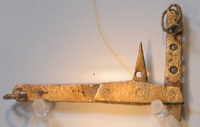 |
 |
 |
 |
 |
 |
 |
|
Fountains Abbey: History
Fountains Abbey: Buildings
|
The terms of tenancy (14/33) Surviving leases show that the tenants and keepers of Fountains were often bound by strict guidelines, and that the community sought to engage suitable leasees; several of the leases state that the keepers or tenants should be ‘of good demeanour, by word and deed.’ (55) Specific targets were fixed, and the tenant was liable for compensating the community if and when these could not be me, or, indeed, if any animals were lost through negligence.(56) The precision with which these documents were drawn up is clearly shown in a fifty-year lease drafted for a widow and her son in 1512, for the keepership of Bouthwaite grange. This also reveals the nature of farming at Bouthwaite and the number of livestock associated with the grange. By the terms of the lease, the keepers agreed to maintain Fountains’ stock of sixty cows, twenty-seven young cattle and two bulls, and to deliver to Fountains each year thirty stirks, eighty stones of cheese and forty of butter. They had also to keep two mares and their foals during the winter. The keepers might pasture their own cattle on the grange here but were obliged to pay £3 6s 8d for the privilege. According to the lease, the widow and her son might retain any profits but were liable for compensating the community should they fail to meet the set targets. Thus, four shillings was charged in lieu of each stirk, eight-pence for every stone of cheese missing and one shilling for each stone of butter. These amounts seem to have been standard, for the keepers of Haddockstones grange were also obliged to provide forty pounds of butter and eighty of cheese butter and cheese, and to pay the same sums in default.(57) In addition to these yearly renders, the keepers of Bouthwaite, like the rest of the abbey’s tenants, had duties at Whitsuntide and Michaelmas. At Whitsuntide, the young cattle (stirks) were brought to the abbey where they were assigned summer pastures, and nine of the oldest cows [crochions] to be fattened on pastures near the abbey, in preparation for slaughtering in the autumn. At Michaelmas, the tenants were obliged to replace these nine old cows with nine heifers.(58) |
